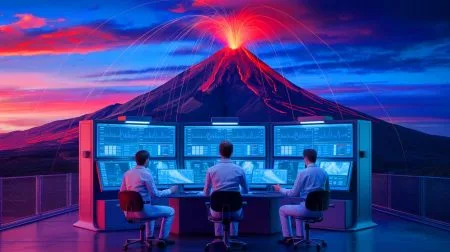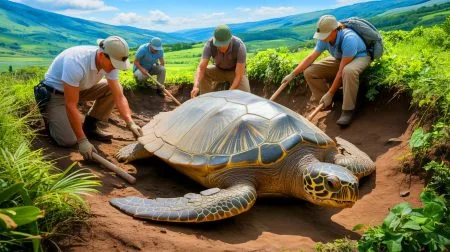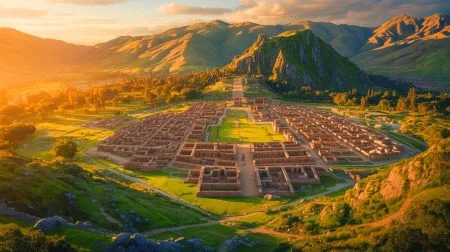| IN A NUTSHELL |
|
The discovery of a new marine turtle species, Craspedochelys renzi, marks a significant milestone in our understanding of ancient marine ecosystems. Unearthed in Colombia, this species dates back approximately 132 million years to the Early Cretaceous period. This finding not only enriches our knowledge of prehistoric life but also provides valuable insights into the evolutionary history of marine turtles. As scientists delve deeper into the implications of this discovery, the broader context of ancient biodiversity and adaptation continues to unfold, offering a fresh perspective on the intricate web of life that once thrived in Earth’s oceans.
The Rediscovery of a Forgotten Fossil
The story of Craspedochelys renzi begins in the 1950s when Swiss geologist Otto Renz discovered the fossil in Colombia’s Guajira Department. Despite its potential significance, the fossil remained largely overlooked in the collections of the Naturhistorisches Museum Basel for over six decades. It wasn’t until recent years that paleontologists recognized this specimen as a new species, shedding light on its importance in the evolutionary history of marine turtles.
This remarkable fossil includes a partial shell measuring approximately 10 inches in length and 9 inches in width, accompanied by hindlimb bones and caudal vertebrae. These components offer a glimpse into the physical structure and adaptations of this ancient turtle species. The discovery underscores the importance of revisiting old fossil collections, where overlooked specimens may hold untapped insights into prehistoric life.
As researchers continue to study Craspedochelys renzi, they are uncovering new chapters in the evolution of marine turtles. This species adds to our understanding of how these ancient reptiles adapted to their environments, providing clues about their ecological roles in ancient aquatic ecosystems.
The Thalassochelydian Connection
Craspedochelys renzi is part of a fascinating group of ancient turtles known as thalassochelydians. These turtles were highly adapted to marine environments, thriving in coastal and marine habitats during the Jurassic and Cretaceous periods. Dr. Edwin-Alberto Cadena from the Universidad del Rosario highlights the specialized adaptations of thalassochelydians, which enabled them to survive in diverse marine conditions.
The thalassochelydians are characterized by their large size, with shell lengths ranging from 15 to 21 inches. Their absence of carapacial fontanelles in adults and other unique features distinguish them from other marine reptiles. The discovery of Craspedochelys renzi enhances the diversity of this group, extending its known geographic range beyond Europe into northern Gondwana.
Found in the Moina Formation, a shallow marine deposit from the Hauterivian age of the Early Cretaceous, this fossil represents the youngest known record of thalassochelydians. The significance of this discovery lies not only in its contribution to the diversity of thalassochelydians but also in its implications for understanding the paleobiogeographic history of ancient marine turtles.
Reevaluating Fossils and Future Discoveries
The discovery of Craspedochelys renzi emphasizes the importance of reevaluating historical fossil collections. Often overlooked specimens can provide new insights into prehistoric life, as demonstrated by this turtle fossil. The rediscovery of this fossil underscores the potential for museums to hold keys to unlocking significant scientific knowledge.
This finding also highlights the complex paleobiogeographic history of coastal and marine turtles during the Early Cretaceous period. The Moina Formation offers a unique glimpse into the diversity of marine life during this era, contributing to our broader understanding of ancient ecosystems. Paleontologists continue to explore the evolutionary dynamics of thalassochelydians, inviting further research into their still-uncertain evolutionary paths.
As more historical collections are revisited, the potential for discovering important fossils that expand our knowledge of ancient marine turtles remains promising. This ongoing research not only deepens our understanding of the past but also informs our insights into the evolutionary processes that have shaped the diversity of life on Earth today.
Unveiling the Secrets of Ancient Marine Life
The discovery of Craspedochelys renzi invites us to reflect on the vastness of ancient marine life and the evolutionary stories waiting to be uncovered. Each fossil holds a unique narrative, offering glimpses into the past and revealing the intricacies of ancient ecosystems. The study of this ancient turtle species not only enhances our understanding of marine turtle evolution but also raises questions about the adaptability and resilience of life in changing environments.
As scientists continue to piece together the story of Craspedochelys renzi, they contribute to a growing body of knowledge that spans millions of years. The rediscovery of this fossil serves as a reminder of the importance of preserving and studying historical specimens, as they hold the potential to unlock new chapters in the history of life on Earth. What other secrets might be hidden in the depths of museum collections, waiting to be revealed?
Did you like it? 4.6/5 (22)






Wow, a sea monster turtle from 132 million years ago? That’s older than my grandma! 😄
Wow, 132 million years old? That’s older than my favorite pair of socks! 🧦
Can someone explain what “thalassochelydian” means? Sounds like a fancy cocktail. 🍹
Why did it take so long for scientists to identify this fossil as a new species?
Is there any connection between this species and modern-day marine turtles?
So, who else is imagining a giant turtle swimming in the ocean like a prehistoric superhero? 🦸♂️🐢
How many more such fossils are lying around unnoticed in museums?
Thank you for sharing this fascinating discovery! It’s amazing how much we can learn from fossils.
Seriously, how did something that old survive an “ocean apocalypse”? 😮
Thanks for the article! It’s mind-blowing to think about the biodiversity that existed millions of years ago.
Could this discovery change our understanding of turtle evolution?
I’m skeptical about these “new species” claims. How do they confirm it’s not just a known species?
How do they know it survived an ancient ocean apocalypse? Is there evidence of this event?
Are there any theories about why this species went extinct?
Can anyone tell me more about the Moina Formation where the fossil was found?
Why was the fossil overlooked for over 60 years? Seems like quite a miss!
Is Craspedochelys renzi the largest marine turtle ever discovered?